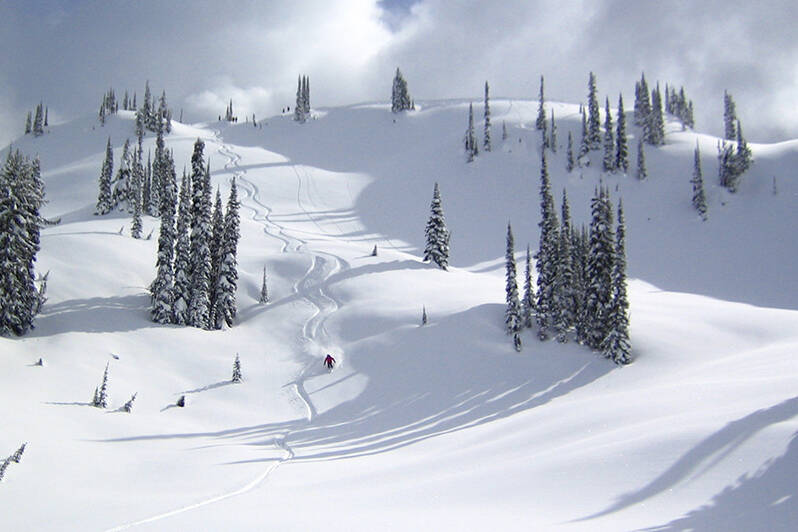Visually impaired skiing has different levels, but the goal is the same: get more visually impaired people onto the slopes.
A few weeks ago, the Revelstoke Review reported on Tyson Rettie and Mark Bentz — two blind skiers who went on a heli-ski trip into the Selkirk mountains with Great Canadian Heli-Skiing to raise money for the Braille Mountain Initiative. The two skied an area near Rogers Pass in the Selkirk Range that was part of Great Canadian Heli-Skiing’s tenure. Rettie broke down how the two skiers took on the challenging terrain and explained what he felt trips like theirs symbolize. Before jumping in a helicopter, it’s key to understand the adaptive options available to visually impaired skiers that can make skiing more accessible.
Corinne Risler, who is a manager of Snowbility and Athlete Development with BC Adaptive Snowsports (BCAS), talked about the different ways that visually impaired skiers can get their turns on the slopes. Risler talked about how BCAS teaches guiding.
“There’s different ways we teach you how to guide someone,” said Risler.
Voice guiding is common in adaptive skiing for the visually impaired. The guide will ski in front of the visually impaired skier and provide information to them as they descend the slope. The commands are often just a single word like, ‘left, right, stop, or hold,’ said Risler. The guides stay close and may ski backwards in front of the skier.
The voice guiding is key to getting the skiers going and comfortable on the mountain. Initially, guides will work in low-risk areas, like a beginner slope. Once the skier has gotten used to working with the commands, the guides will take them higher.
READ MORE: ‘Reclaimed Voices’: Revelstoke Museum and Archives planning new exhibit
In bigger terrain, the guides must spread out from the skiers, so the communication is aided by some technology.
“We use motorcycle helmet headsets to voice guide,” said Risler.
Using the headsets, the guide can keep their distance from the skier while still giving them instructions.
Some visually impaired skiers may have partial sight, so another adaptation that guides can work with is wearing a high visibility vest to make it easier for the skier to spot them.
Rettie’s loss of vision was the result of a mitochondrial disease.
“My vision loss was very rapid,” said Rettie.
It took just a couple of weeks for the disease to affect his right eye and less than a year before reaching his left.
After years working as a guide, predominantly in the mechanized industry, Rettie was eager to get back to skiing but it came with challenges.
“Initially, it was a very slow and stressful process — really lacking in confidence, flow, and I had to work really hard to build up the level of confidence to be without knowing for sure I wasn’t gonna crash or hit anything,” said Rettie.
When Rettie founded Braille Mountain Initiative in 2020, he wanted to get blind and visually impaired people into backcountry mountain sports.
“The idea is we want to create an environment where people have the opportunity to gain the skills and experience necessary to continue to participate in these sports without the ongoing assistance of Braille Mountain Initiative,” said Rettie.
When Bentz and Rettie went on their trip, they didn’t have a guide at all. Trips like the ones they did aren’t entry level expeditions, but Rettie said that’s the point.
“This is something that you’ll see on the horizon as a goal to work towards. I think that’s something that everyone needs. We all need something to be striving towards,” said Rettie.
Their ski trip was to raise funds for the Braille Mountain Initiative, which helps fund expeditions into the backcountry for the visually impaired. Rettie and Bentz will be heading out for another trip to Sorcerer Lodge in mid-April. They are still raising funds for their Blind Heli-Skiing Challenge, and welcome all donations.
For adaptive skiers at resorts, Risler said that the best way for other skiers to help is to give them space when they see them.
“Sometimes if someone has partial vision and someone speeds close by to them, they don’t necessarily see them in the peripheral vision. And so, it kind of startles them,” said Risler.
Whether it is high above the ground atop a mountain in the Selkirks, or at a resort, Risler summed up what BC Adaptive Snowsports and the Braille Mountain Initiative shared.
“We should always give people with different barriers opportunities to enjoy adaptive snowsports.”
READ MORE: Arrow Lakes Caribou Society successfully capture 14 caribou in one day
@ZacharyDelaney
zach.delaney@revelstokereview.com
Like us on Facebook and follow us on Twitter and subscribe to our daily and subscribe to our daily newsletter.

